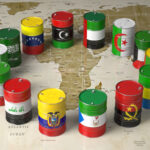Oil prices surged more than 45% in the first six months of 2021, rallying toward $80 a barrel for the first time in more than two and a half years.

Analysts on Wall Street believe there is potential for crude markets to climb even higher in the coming months, although not everyone is convinced that’s the case.
International benchmark Brent crude futures traded at $75.76 a barrel on Friday, down around 0.11%. The oil contract recorded gains of more than 45% through to the end of June, having stood at $51.80 on Jan. 1.
U.S. West Texas Intermediate futures traded at $74.28 during early deals in London, almost 0.1% lower. WTI posted gains of more than 51.4% during the first six months of the year.
Brent futures rose more than 8% in June while WTI climbed over 10%, reaching their highest levels since Oct. 2018.
Analysts attribute the oil price rally to a combination of factors, including the rollout of Covid-19 vaccines, a gradual easing of lockdown measures and massive production cuts from OPEC and non-OPEC members — an energy alliance known as OPEC+.
What next for oil prices?
Looking ahead, Goldman Sachs sees Brent prices averaging above $80 in the third quarter, with potential spikes “well above” that level as demand comes roaring back. JPMorgan, meanwhile, expects crude oil prices to “decisively” break into the $80s during the final three months of the year.
It comes as all three of the world’s main forecasting agencies — OPEC, the International Energy Agency and the U.S. Energy Information Administration — expect a demand-led recovery to pick up speed in the second half of 2021.
Tamas Varga, oil analyst at PVM Oil Associates, said global and regional oil inventories have been falling so far this year, supporting oil prices. “This trend is set to continue for the rest of the year,” he added.
It “would only come to an abrupt end if central banks start increasing interest rates unexpectedly because of fear of inflation or in case OPEC raises production above demand — or they fail to accommodate extra Iranian barrels if the Persian Gulf OPEC member comes back to the market.”
The prospect of OPEC+ failing to accommodate additional Iranian oil exports “looks unlikely at the moment,” Varga said.
Morgan Stanley on what happens at $80
A number of uncertainties continue to cloud the outlook, however. The spread of the delta Covid-19 variant worldwide has exacerbated concerns of a setback to oil demand and the potential of Iranian exports returning to the market remains unclear.
Renewed lockdown measures and rising costs have already resulted in slower factory growth in China, for example.
Martijn Rats, chief oil analyst at Morgan Stanley, said crude markets were effectively searching for the price of oil that would start to destroy demand growth.
“It is a difficult thing to analyze, we put it at around about $80 a barrel or so,” Rats told CNBC’s “Street Signs Europe” on Thursday.
“Above that, we would expect quite a bit of demand destruction to kick in,” he continued. “That then would have implications for economic growth because if oil demand doesn’t grow quite as fast anymore then an awful lot of other industrial economic processes depend on that.”
To be sure, Morgan Stanley believes Brent will trade between $75 to $80 through to the middle of 2022.
On Thursday, OPEC and its non-OPEC partners, an energy alliance often referred to as OPEC+, opted to delay a decision on whether to ramp up oil supply. Sources told Reuters that the UAE had blocked a plan for an immediate easing of supply cuts.
The Middle East-dominated producer group will meet again Friday when talks will continue.
Chris Midgley, global head of analytics at S&P Global Platts, said the OPEC+ meeting would have a “strong bearing” on oil prices since the outcome will impact supply from next month.
“Platts Analytics believes prices could briefly test the high 70′s before prompt European buying starts to wane at the end of July and potential return of Iranian barrels enable Brent to retrace down to low 70s,” Midgley told CNBC via email.
“OPEC may look to hold prices above $70/bbl but ultimately the forward curve suggests fair value slightly below,” he added.
[contextly_sidebar id=”dNtNzTQ1p2vyXOm8HVaRS7wqizSdtmC6″]







